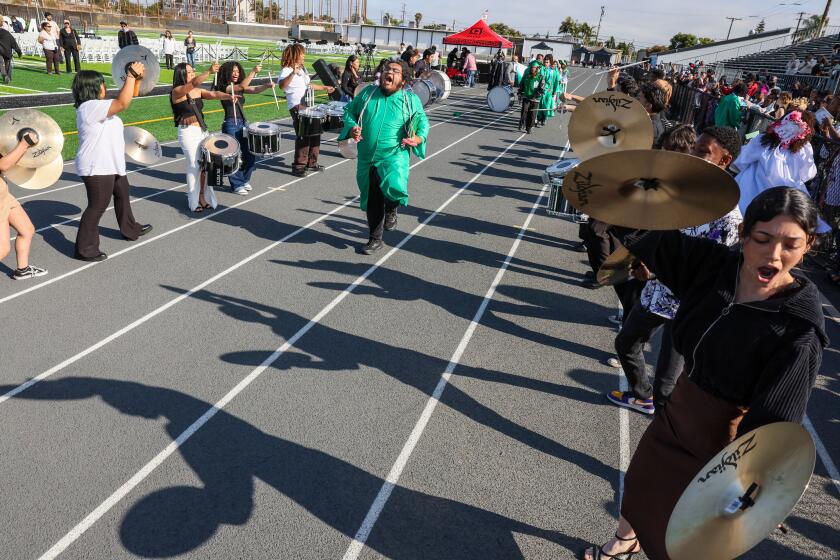Practical Take on Math Adding Up in Santa Ana : Education: Scores posted by students at Spurgeon Intermediate are rising, thanks to help from a national project called QUASAR.
Instead of memorizing endless geometric formulas, sixth-graders at Spurgeon Intermediate School are learning geometry by building homes and businesses out of construction paper and laying them out in a town they have named “Polyhedraville.”
Working in groups, the students are learning how to calculate the square-unit cost of each solid figure, or “polyhedron,” and determine the area and length of the three-dimensional buildings and roads they’re constructing.
“This unit is helping the kids visualize geometry,” said Rick Doty, who instructs the class. “Instead of teaching geometry in the traditional way, we’re actually working with shapes to learn about perimeters, areas, surface areas and a number of other geometric concepts.”
Such a hands-on assignment is typical at Spurgeon Intermediate, which for the past four years has taken part in a nationally-acclaimed math program called QUASAR, which stands for Quantitative Understanding: Amplifying Student Achievement and Reasoning.
QUASAR is a joint project between the University of Pittsburgh and the Ford Foundation, which launched the program in 1990 with a $10-million grant. Along with Spurgeon Intermediate in the Santa Ana Unified School District, the project is being carried out at middle schools in Milwaukee, Philadelphia, Atlanta, Portland, Ore. and Holyoke, Mass.
The purpose of QUASAR is to boost the math performance of students in low-income areas by teaching them higher-level math skills, said Margaret Smith, coordinator of the QUASAR project at the University of Pittsburgh.
“QUASAR was developed on the premise that the poor performance of low-income students is due to the lack of access to good mathematics,” Smith said. “We wanted to show that all students are capable of doing well in math, no matter how economically disadvantaged they are.”
So far, the results at Spurgeon Intermediate have been fairly impressive.
Spurgeon used to have the lowest math scores among the seven middle schools in the Santa Ana school district on the California Test of Basic Skills. But last year, scores rose, particularly at the eighth-grade level. Within the district, Spurgeon’s eighth-graders posted the second-highest gains in math when comparing scores from the sixth grade.
Generally, students at all three grade levels still rank below the district average in math, but they are no longer at the very bottom, school officials said.
“We moved up a couple of notches in our position within the district,” said Doty, who has taught at the school since 1985. “Before, when we were always at the bottom, it was like one of those things where you try and try and constantly get dumped on. We tried to figure out why, and it always sounded like a bunch of excuses.”
In light of its historically low scores, the school became a perfect candidate for QUASAR, which targeted schools in low-income areas that were willing to revamp their math programs.
“One of our pluses was that we had no place to go but up,” said Doty, who coordinates the QUASAR project on campus.
Located on West 5th Street off Fairview Street, Spurgeon educates a large number of students with limited English skills and students living in poverty, said Principal Lyn Maher.
More than three-fourths of the 1,300 students at the school receive free or reduced lunches, while 78% of the sixth-, seventh- and eighth-graders have limited English skills. About 90% of the students at the school are Latino, 6% are Asian, 2% are black and 2% are white, Maher said.
Through extensive staff development, QUASAR essentially has altered how students learn math at Spurgeon and other participating schools.
In the past, students learned basic math skills through drills and rote class assignments. Now, students learn advanced math concepts by working in groups and using calculators, computers and other tools.
For instance, sixth- and seventh-graders at Spurgeon are learning geometry by designing their own homes using a computer program called “Architect 4.2.” Meanwhile, seventh-graders are learning how to apply unit values by calculating the cost of fruits and vegetables by weight.
“Our kids are learning real life skills when they learn these math concepts,” Maher said.
Math used to be be extremely difficult for Miguel Ortiz, an eighth-grader at the school. But now, he said it’s one of his favorite subjects.
“Math seems easier to me now because my teachers explain it better,” he said. “It’s the same problems, but we learn it a better way. We work a lot in groups, so we can ask each other questions to figure out the answers.”
Spurgeon received a $450,000 grant from the Ford Foundation in 1991 to implement the QUASAR program. The grant expires this year, but the state has awarded the school a $25,000 grant for the next three years to continue the program. The Ford Foundation has agreed to match that grant for the next two years.
“After using the QUASAR method, I couldn’t teach any other way,” said Susan Mercer, a teacher at the school. “We’re getting students involved and allowing them to feel successful.”
More to Read
Sign up for Essential California
The most important California stories and recommendations in your inbox every morning.
You may occasionally receive promotional content from the Los Angeles Times.






